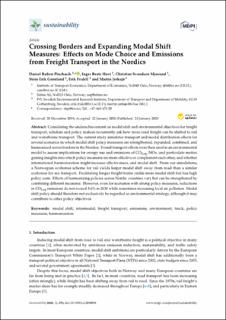Crossing borders and expanding modal shift measures: effects on mode choice and emissions from freight transport in the Nordics
Pinchasik, Daniel Ruben; Hovi, Inger Beate; Mjøsund, Christian S.; Grønland, Stein Erik; Fridell, Erik; Jerksjö, Martin
Journal article, Peer reviewed
Published version
Permanent lenke
https://hdl.handle.net/11250/2643721Utgivelsesdato
2020Metadata
Vis full innførselSamlinger
- Publikasjoner fra CRIStin - BI [1015]
- Scientific articles [2181]
Sammendrag
Considering the underachievement on modal shift and environmental objectives for freight transport, scholars and policy makers recurrently ask how more road freight can be shifted to rail and waterborne transport. The current study simulates transport and modal distribution effects for several scenarios in which modal shift policy measures are strengthened, expanded, combined, and harmonized across borders in the Nordics. Found transport effects were then used in an environmental model to assess implications for energy use and emissions of CO2,eq, NOx, and particulate matter, gaining insights into which policy measures are more effective or complement each other, and whether international harmonization might increase effectiveness, and modal shift. From our simulations, a Norwegian ecobonus scheme for rail yields larger modal shift away from road than a similar ecobonus for sea transport. Facilitating longer freight trains yields more modal shift but has high policy costs. Effects of harmonizing policies across Nordic countries vary but can be strengthened by combining different measures. However, even for scenarios with strong policy measures, reductions in CO2,eq emissions do not exceed 3.6% in 2030 while sometimes increasing local air pollution. Modal shift policy should therefore not exclusively be regarded as environmental strategy, although it may contribute to other policy objectives.

